
One of the sites I've been working on for almost a year now has gone live: National College for Leadership of Schools and Children's Services. Responsible for markup, styling and scripting, the site went through numerous visual and requirement changes before the current layout and design was settled upon.
a benchmark for design, usability and accessibility, catering to a wide audience without compromising aesthetics
Starting in November 2008 with the then named NCSL (National College for School Leadership), the number of templates could be counted on two hands and script components were non-existent; since then the brand and colour scheme have changed, a font replacement library has been implemented, upgraded then changed (
sIFR version two, then three, then
Cufon), script components now include tabs, social bookmarking, tooltips and a fully-featured carousel, and the number of templates has ballooned to encompass a wide variety of pages including a number of
member-only pages most site visitors will never see.
The client had a very strict set of requirements regarding accessibility, usability and aesthetics, the site was a great challenge and it's brilliant to see it go live. With it now out in the wild, it's a good opportunity to examine just some of the notable aspects of the project.
Read the rest of this entry


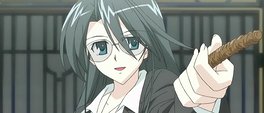
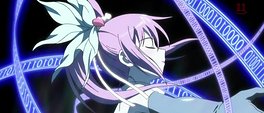
There are many good panty episodes in anime: episode four of Mai-HiME springs to mind as one, episode three of Yoku wakaru gendai mahou is not. Whereas the former had comic timing well beyond what one would have expected its studio to be able to produce, the latter is tawdry, boring tripe and is just the crowning achievement of an another muddled and bland instalment in the chicks-with-sticks and magic genre.
arcane magic of the hand-waving, runic variety and the "modern" magic of binary and cellphones
The series opens strongly with a battle against a sharply dressed wizard by two small girls who promptly get pummelled; rewinding six hours, the viewer is then treated to the first (and likely not the last) exposure of a criminally underage girl's posterior - while being chased by the impossibly sedate antagonist and engaging in some cryptic dialogue with other notable cast members. The public display of flesh is uncomfortable viewing, not only for the implied age of the participant but the futility of its inclusion - lacking any development of characters or story, it borders on pornography. From this low starting point, the first three episodes stumble haphazardly around like a late-night drunkard: first episode events are neither explained or explored and it's only upon reflection that the upcoming twist is made obvious. Elsewhere, characters who were no more than bystanders are now learning magic with the protagonist while incidents are nothing more than contrivances for character collisions. All of this set to a constant barrage of camera angles designed to place the poorly drawn breasts of the more well endowed females front-and-centre.
Read the rest of this entry
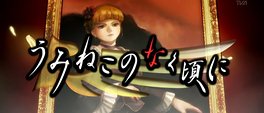

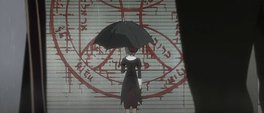
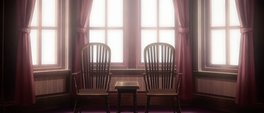
So how are we going to follow Higurashi? We can't diverge too much from the formula otherwise people won't like it! What about if we set it on an island? And use a bunch of aristocrats instead of teenagers! We'll have to have some annoying teenagers in there somewhere. And a creepy child! But keeping with the murder theme? We'll use a witch this time, totally different from the demon we had scuttling about in Higurashi...
her insistence on emitting an infuriating noise at the slightest provocation
And so the first three episodes of Umineko naku koro ni unfold in a similar but no less enticing way than its predecessor, Higurashi no naku koro ni. Building on the success of its forerunner, Umineko continues the same malevolent and supernatural atmosphere while subtly twisting it into its own beast. With nary a reset in sight, the nouveau rich are bumped off with surprising speed until only a select few are left to solve the mystery of whether a witch is to blame (similar in nature to when wizards do it) or whether one of their own is taking up finger painting with other people's blood. The switch from a remote village to a closed-off island serves the same isolating purpose but opens up the alluring possibility of using the island itself as an antagonist rather than simply letting the box of scorpions scenario play out; likewise the shift from village dwellers to an affluent family keeps the paranoia and tension running thick. Indeed, the story revealed in the first episodes of Umineko is just as captivating as the first arc of Higurashi.
Read the rest of this entry
My Sunday afternoon project wasn't something that I could just let lie and it didn't take long for work to start on it again. Using the list of improvements I had identified, I began with the aesthetics and then moved on to other, more number intensive areas of research.
Before even touching the code I subsumed everything into a Git repository; I'm a long time Subversion user but relatively new to Git so I still regularly refer back to the "Git - SVN Crash Course" which is pleasantly concise. With this done, I attacked the GIF output method first:




cooked up in a few hours and wasn't subject to any stringent mathematical basis
First was visibly increasing the size of the cells, I had originally used a multiplier of four for previous iterations but that made them very indistinct, and with only fifty generations it meant a large portion of the space wasn't used. The result was an increase in cell size to seven with a one pixel border: this was the result of a happy accident while crafting the previous post and resulted in the introductory images, however the calculations for the edge cells was incorrect which is why those animations don't appear to "loop" at the edges as they should. This implementation fixed that and with a vastly smaller environment (only 8x8 with a 5x5 seed), each generation of cells and their progression is easier to see. Next was addressing the colour issue, generating both a background and foreground colour met with mixed results so taking a leaf from
WP_Identicon's book, I kept the background colour constant and generated the foreground colour only:
Read the rest of this entry












